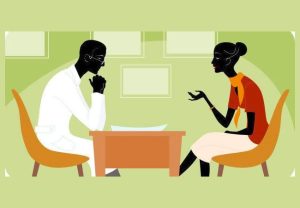
LARA ADEJORO writes that a new wireless interface technology is offering hope to individuals with paralysis to lead productive, independent lives.
Technological breakthroughs are drastically revolutionising healthcare delivery across the world and providing better health outcomes for patients.
Advancements in technology have remarkably solved numerous health conditions such as tuberculosis, diabetes, heart failure, spinal cord injury, and tuberculosis, among others.
Recently, 40-year-old Gert-Jan Oskam was able to walk again after 12 years, with the use of a ‘digital bridge’ developed by Swiss researchers.
Oskam was paralysed after a fatal cycling accident that took place in 2011.
According to Radio France Internationale, Oskam, who is from the Netherlands, lost the use of his legs after suffering a spinal cord injury following the accident in China.
Presently, Oskam is back on his feet and walking – just by thinking about it, thanks to a device that creates a ‘digital bridge’ between his brain and the nerves below his injury.
According to the World Health Organisation, SCI refers to damage to the spinal cord resulting from trauma (e.g. a car crash) or from disease or degeneration (e.g. cancer).
Oskam’s case, titled “Walking naturally after spinal cord injury using a brain–spine interface,” was published in the journal Nature in May 2023.
The researchers said the experiments were carried out as part of the ongoing clinical feasibility study of brain-controlled spinal cord stimulation in patients with SCI, which investigates the safety and preliminary efficacy of brain-controlled spinal cord stimulation after spinal cord injury.
The researchers said, “A spinal cord injury interrupts the communication between the brain and the region of the spinal cord that produces walking, leading to paralysis. Here, we restored this communication with a digital bridge between the brain and spinal cord that enabled an individual with chronic tetraplegia to stand and walk naturally in community settings.
“This brain–spine interface consists of fully implanted recording and stimulation systems that establish a direct link between cortical signals and the analogue modulation of epidural electrical stimulation targeting the spinal cord regions involved in the production of walking. A highly reliable BSI is calibrated within a few minutes. This reliability has remained stable over one year, including during independent use at home.
“The participant reports that the BSI enables natural control over the movements of his legs to stand, walk, climb stairs, and even traverse complex terrains. Moreover, neurorehabilitation supported by the BSI improved neurological recovery. The participant regained the ability to walk with crutches over ground, even when the BSI was switched off. This digital bridge establishes a framework to restore natural control of movement after paralysis.”
Speaking with our correspondent, a Professor of Neuroscience, École Polytechnique Fédérale in Lausanne, Grégoire Courtine, who led the project, said over 200 researchers worked on the development for over 15 years.
The researcher said he is hopeful that the implant be available to patients before the end of the decade.
He said seeing Oskam walk again “brings a lot of emotions.”
Asked if there are more stages required for the innovation, he said, “Yes with our company, Onward, that will miniaturise the system.”
RFI quoted Oskam as saying, “Now I can just do what I want – when I decide to make a step the stimulation will kick in as soon as I think about it.”
Oskam added that it had been “a long journey to get here.”
But among the “simple pleasures that represent a significant change,” RFI noted that he highlighted being able to stand at a bar again with friends and have a beer.
The WHO said there is no reliable estimate of global prevalence, but the estimated annual global incidence is 40 to 80 cases per million population. Up to 90 per cent of these cases are due to traumatic causes, though the proportion of non-traumatic spinal cord injury appears to be growing.
The global health body said around the world, between 250,000 and 500,000 people suffer a spinal cord injury every year.
It said the majority of spinal cord injuries are due to preventable causes such as road traffic crashes, falls, or violence.
It noted that “People with a spinal cord injury are two to five times more likely to die prematurely than people without a spinal cord injury, with worse survival rates in low- and middle-income countries. Spinal cord injury is associated with lower rates of school enrollment and economic participation, and it carries substantial individual and societal costs.
A study titled ‘Complications and Causes of Death in Spinal Cord Injury Patients in Nigeria,’ published in the West African Journal of Medicine, analysed 422 patients admitted at the University of Abuja Teaching Hospital, Gwagwalada, and at the National Orthopaedic Hospital Lagos for SCI from January 1997, to December 2007, and found that the majority of SCI patients are young male adults.
The study showed that road traffic injury remains the most common cause of SCI in Nigeria.
It further said complications following SCI in Nigeria are high. In the study, the figure was put at 94.8 per cent.
The researchers led by a spine surgeon at the Department of Orthopaedics at UATH, Gwagwalada, Dr. Ahidjo Kawu said, “Our study has shown that the commonest complications noted in SCI patients are muscle spasms and neurogenic pain but the commonest causes of death are respiratory failure and septiceamia. The mortality rate six months post-injury is quite high.
“Predictors of complications are CSI and Frankel type A injury. Age, cervical spine injury, Frankel type A injury and Glasgow coma scale greater than nine at presentation all lead to an adverse outcome.”
Also, a study by two experts at the Department of Orthopaedic and Trauma Surgery, National Orthopaedic Hospital, Lagos, Nigeria, on the epidemiology and clinical outcomes of spinal cord injuries at a level II trauma centre in Nigeria, showed that 99 cases of traumatic SCI were recorded between January 2013 and December 2017.
The patients’ estimated age was 24 to 50 years with a male predominance of 68.7 per cent with the working age group accounting for 83.9 per cent of cases.
According to them, motor vehicular accidents and falls accounted for 62.6 per cent and 22.2 per cent respectively.
“About a third of the cases (32.3 per cent) presented within 24 hours of injury. The most frequently affected level was the cervical spine (63.6 per cent), and complete tetraplegia was the most prevalent clinical pattern (31.3 percent),” they said.
They noted that there is a need for strategic interventions to reduce MVA and improve pre-hospital care and health policies to ensure early definitive care.
Yet again, a study carried out by a team of experts on the epidemiological and treatment profiles of SCI in southeast Nigeria noted that the disability associated with the burden of SCI, especially in the region remains overwhelming, justifying a further look into them to propose solutions aimed at minimising the disease burden.
It said SCIs in southeast Nigeria are now mainly due to MVAs, because falls that used to be the most common cause due to the high frequency of falls from palm trees have dramatically decreased due to the replacement of tall species of palm trees over the years with short species that can be harvested without climbing.
The researchers, however, said adequate education and sensitisation of people in implementing road maintenance culture and road safety measures may reduce MVAs, as happened with falls through the replacement of tall species of palm trees by short ones.
“Proper education of our population might bring about more carefulness during festive periods, especially while driving motor vehicles, and may also help change the negative attitude of our population towards the role of ambulance and emergency medical services in SCI care,” they added.
Commenting on the development, a Professor of Clinical Neurology and Internal Medicine at the College of Medicine, University of Nigeria, Enugu, Ikenna Onwuekwe, said though the innovation is still a developing technology, it is exciting because of its potential to help people with such conditions.
He said there is no doubt that it will receive the necessary regulatory approvals.
“We are now seeing technology that has allowed the mind-machine complex to be actualised. Everything about the nervous system functions through electrical current, we have technology that can read electrical signals like the electroencephalogram, electrocardiogram, and electromyography and they can pick up signals from within the various aspect of the nervous system; that was the basis and it has advanced beyond that stage.
“If we can pick these signals, we could develop technology that can modify the signals and that is what has happened. Now, using the advancement of the same technology, we now have computers and other machinery that can allow thought processes to be translated and transmitted to other parts of the body with machinery in-between, thus allowing you to move parts of the body that had been previously separated from the nervous system; whether it is traumatic injury following accidents or what has cut through the spinal cord, or diseases, that the circuitry in the brain can now be connected through machines to circuitry in the muscles of the limbs and people can be taught to activate their muscles just by thinking about it and make the muscles move.”
Prof. Onwuekwe, however, said the technology works on two principles – the muscles must be alive and active, and the individual must be conscious and lucid.
“If the muscles are dead, you may not be able to move them again. The individual must be lucid enough to form clear thoughts and other cognitive processes.
“Nigeria can still appreciate the technology and hope that it will be available for people here,” he said.
Also commenting, a Consultant Anaesthetist at the UATH, Gwagwalada, Dr. Nnanna Agwu, said the technological advancement is a very welcomed development.
“Whatever can be done to ensure that patients with spinal cord injury get back to function as fully as possible is okay. You cannot imagine the joy these patients and their relations will have to be able to walk or carry out certain functions they couldn’t do before.
“The BSI technology tends to bypass the site of injury to communicate with the part of the spinal cord responsible for walking, via prototypes of a nerve stimulation device remotely controlled by artificial intelligence software.
“For us as Nigerians, it is good news to know that this technology is available now. However, I am not aware if it is available in the country at this moment. So, it behooves our scientists to study this technology and seek ways to domesticate the technology. It is not beyond us as Nigerians, as we have been adjudged to have some of the best brains in the world.
“Also, since it is a new technology, it may be a lot more expensive and out of the reach of the poor. So, by and large, it is a good development that should challenge the scientific community in Nigeria to do more for our patients irrespective of the challenges in healthcare delivery.”
In 2018, News Medical reported that three paralysed men were able to take their first steps after their accidents due to spinal implants from doctors in Switzerland.
Also in 2022, an Italian-German, Michel Roccati was reported to the first man with a completely severed spine to walk again.
Roccati, on his website- michelroccati.com, wrote, “In 2017, after a motorcycle accident, I had a complete spinal cord injury, which prevented me from using my lower limbs. As of 2020, I am the first person in the World to regain mobility in my legs and return to walking after a complete spinal cord injury.
“This, thanks to the participation in Switzerland, in an innovative experimental biomedical research project called ‘Stimo’. The operation involves installing special electrodes subcutaneously in the back below the spinal cord injury.”
Copyright Reportr Door
All rights reserved. This material, and other digital content on this website, may not be reproduced, published, broadcast, rewritten or redistributed in whole or in part without prior express written permission from Reportr Door.
Contact: [email protected]




